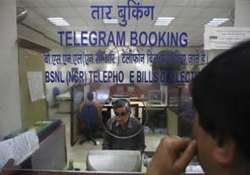Curtains for 163-year-old telegram service
New Delhi, July 14: The 163-year-old telegram service in the country - the harbinger of good and bad news for generations of Indians - is dead.Once the fastest means of communication for millions of people,

New Delhi, July 14: The 163-year-old telegram service in the country - the harbinger of good and bad news for generations of Indians - is dead.
Once the fastest means of communication for millions of people, the humble telegram was today buried without any requiem but for the promise of preserving the last telegram as a museum piece.
A large people, many of them youngsters and first timers, turned up at four telegraph centres in the Capital which have almost been forgotten in recent years to send a message to their loved ones on the last day of the service.
“This is the first time I am sending a telegram. It is for my 96-year-old grandfather who lives in a village near Trichy,” Anand Sathiyaseelan, a lawyer by profession, said. A manager in a real estate firm Vikas Arvind said he was sending greetings to his parents in Bareilly.
“This I hope they will keep it as a memorabilia,” Arvind said.
“Hope all is well” and “An iconic service comes to an end” were among the messages sent today.
Started in 1850 on an experimental basis between Koklata and Diamond Harbour, it was opened for use by the British East India Company the following year. In 1854, the service was made available to the public.
It was such an important mode of communication in those days that revolutionaries fighting for the country's independence used to cut the telegram lines to stop the British from communicating.
Though started as a Morse code service, the telegram service evolved gradually with the use of computers. At the time of its death, it had become a web based telegraph mailing service (WBTMS) which used emails to instantly convey message to the other end.
Nudged out by technology --- SMS, emails, mobile phones—the iconic service gradually faded into oblivion with less and less people taking recourse to it. ld timers recall that receiving a telegram would be an event itself and the messages were normally opened with a sense of trepidation as people feared for the welfare of their near and dear ones.
For jawans and armed forces seeking leave or waiting for transfer or joining reports, it was a quick and handy mode of communication.
Once the fastest means of communication for millions of people, the humble telegram was today buried without any requiem but for the promise of preserving the last telegram as a museum piece.
A large people, many of them youngsters and first timers, turned up at four telegraph centres in the Capital which have almost been forgotten in recent years to send a message to their loved ones on the last day of the service.
“This is the first time I am sending a telegram. It is for my 96-year-old grandfather who lives in a village near Trichy,” Anand Sathiyaseelan, a lawyer by profession, said. A manager in a real estate firm Vikas Arvind said he was sending greetings to his parents in Bareilly.
“This I hope they will keep it as a memorabilia,” Arvind said.
“Hope all is well” and “An iconic service comes to an end” were among the messages sent today.
Started in 1850 on an experimental basis between Koklata and Diamond Harbour, it was opened for use by the British East India Company the following year. In 1854, the service was made available to the public.
It was such an important mode of communication in those days that revolutionaries fighting for the country's independence used to cut the telegram lines to stop the British from communicating.
Though started as a Morse code service, the telegram service evolved gradually with the use of computers. At the time of its death, it had become a web based telegraph mailing service (WBTMS) which used emails to instantly convey message to the other end.
Nudged out by technology --- SMS, emails, mobile phones—the iconic service gradually faded into oblivion with less and less people taking recourse to it. ld timers recall that receiving a telegram would be an event itself and the messages were normally opened with a sense of trepidation as people feared for the welfare of their near and dear ones.
For jawans and armed forces seeking leave or waiting for transfer or joining reports, it was a quick and handy mode of communication.
